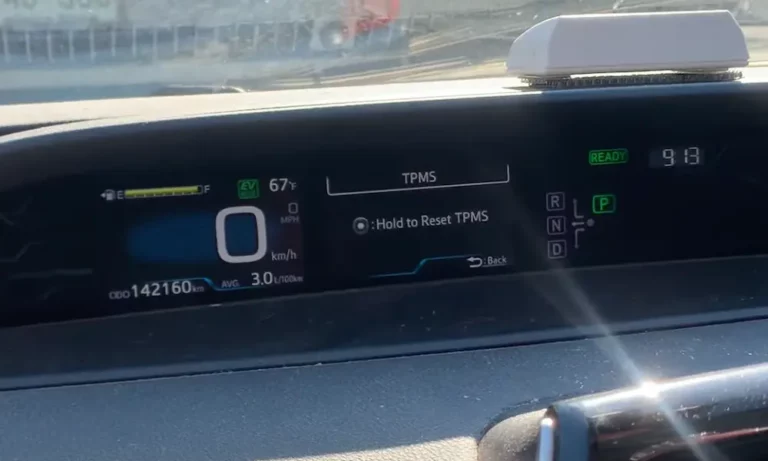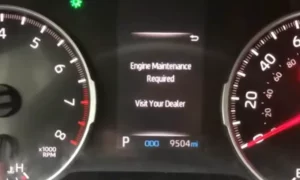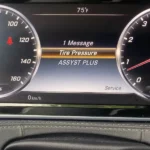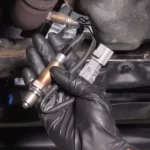Seeing that annoying tire pressure light on your Prius dashboard? You’re about to learn exactly how to make it disappear. The Toyota Prius tire pressure monitoring system (TPMS) is there to keep you safe, but after you’ve properly inflated your tires, that stubborn warning light might still be glowing at you.
No worries – this guide covers everything you need to know about resetting your Toyota Prius tire pressure sensor, from older models with hidden buttons to newer ones with fancy digital displays. Let’s get that light turned off so you can get back to enjoying your fuel-efficient ride.
What is the Toyota Prius TPMS and Why Does it Need Resetting?
The Tire Pressure Monitoring System in your Toyota Prius uses sensors inside each wheel to constantly monitor air pressure. When pressure drops below the recommended level, a warning light appears on your dashboard – typically looking like a tire with an exclamation point.
After you’ve checked and properly inflated your tires, the system needs to be reset to recognize the new, correct pressure readings. Without a reset, the light stays on even though your tires are properly inflated.
The National Highway Traffic Safety Administration considers proper tire inflation essential for safety, which is why the TPMS system was mandated for all vehicles. Properly inflated tires improve handling, reduce blowout risks, boost fuel efficiency, and extend tire life.
Tools Needed for Toyota Prius TPMS Reset
Before starting the reset process, make sure you have:
- A reliable tire pressure gauge
- Access to an air compressor (at home or at a gas station)
- Your Prius owner’s manual for reference
- A clear understanding of your specific Prius model year
That’s it! No special tools required – just your fingers and a few minutes of your time.
Checking Tire Pressure Before Reset
Before resetting the system, always verify your tires have the correct pressure:
- Check pressure when tires are cold (vehicle hasn’t been driven for at least 3 hours)
- Remove the valve cap from each tire
- Press the pressure gauge firmly onto the valve stem
- Read the displayed pressure
- Compare with the recommended PSI
For most Prius models, the recommended pressure ranges between 32-36 PSI, with front tires sometimes needing slightly higher pressure than rear tires. You’ll find the exact specifications on a sticker inside your driver’s side door jamb.
Resetting TPMS on 2009-2013 Toyota Prius Models
These older Prius models use physical buttons for the reset process. Here’s how to handle specific model years:
2009 Prius TPMS Reset Procedure
- Park safely and set the parking brake
- Press the power button with your foot on the brake
- Locate the TPMS reset button below the steering wheel
- Press and hold the button until the TPMS light flashes three times slowly
- Turn off the vehicle and you’re done
2010-2012 Prius TPMS Reset Method
- Turn the ignition to “ON” position (press power button twice without pressing brake)
- Find the TPMS reset button (usually located near the left knee panel)
- Press and hold for 2-3 seconds until the light blinks three times
- Turn off the ignition and restart the vehicle
2013 Prius V Hidden Button Method
The 2013 Prius V has a sneaky hidden button:
- Turn on the car with your foot on the brake
- Look above the brake pedal, past the OBD-2 port
- Locate the small button positioned well above the brake pedal
- Press and hold for approximately 10 seconds until the TPMS light turns off
Toyota really tucked this one away – you might need to bend down and look up toward the dashboard to find it.
Resetting TPMS on 2014-2015 Toyota Prius Models
These transition-year models have a slightly different procedure:
- Ensure all tires are properly inflated
- Turn the ignition switch to “ON” position (don’t start engine)
- Press and hold the TPMS reset button until the light flashes three times
- Start the engine and drive for at least 10 minutes at speeds above 16 mph to complete calibration
Resetting TPMS on 2016-2020 Toyota Prius Models
Newer Prius models use the digital display and steering wheel controls. Here’s the process:
2016 Prius Hybrid TPMS Reset
- Turn on your car without starting (press push-start twice without foot on brake)
- Use the steering wheel buttons to navigate to the vehicle settings page
- Select “maintenance system” and press enter
- Choose “TPMS” and press enter
- Press and hold the enter button until initialization is complete
- The screen will confirm successful reset
2017-2018 Prius TPMS Digital Reset
- Turn on the ignition without starting the engine
- Use the arrow buttons to navigate to vehicle settings (car icon)
- Select “maintenance system” by pressing the center button
- Select “TPMS” and press the center button again
- When prompted to “hold to reset TPMS,” press and hold the center button
- Wait for “initialization completed” message
- Press back multiple times to return to normal display
2019-2020 Prius Models
- Check tire pressures (typically 36 PSI front, 35 PSI rear)
- Press the power button twice without pressing the brake
- Use the d-pad on the steering wheel to navigate to settings (gear icon)
- Select “vehicle settings” → “maintenance system” → “TPMS”
- Hold the center button until you see initialization confirmation
- Drive for at least 10 minutes to complete the process
Resetting TPMS on 2021-2023 Toyota Prius Models
The newest Prius models have a streamlined procedure:
- Ensure all tires are properly inflated
- Press the power button twice without pressing the brake pedal
- Navigate through the multi-information display to “Settings”
- Select “Vehicle Settings” → “TPMS Setup” → “Set Pressure”
- Press and hold the “OK” button until you see confirmation
- Drive the vehicle for at least 10-15 minutes to complete the calibration
Common TPMS Warning Light Patterns and What They Mean
Understanding the different warning patterns helps diagnose issues:
| Warning Pattern | What It Means | Required Action |
|---|---|---|
| Solid light | Low tire pressure detected | Check and inflate tires, then reset TPMS |
| Light flashes for 1 minute, then stays solid | System malfunction | Professional diagnostic needed |
| Light comes on after driving a while | Pressure dropped during drive | Check tires as soon as safely possible |
| Light comes on in cold weather | Pressure dropped due to temperature | Check pressure in morning, adjust if needed |
Troubleshooting When TPMS Reset Doesn’t Work
If your reset attempts fail, here are common issues and solutions:
Dead Sensor Batteries
TPMS sensors contain batteries lasting 5-7 years. If the light blinks several times before staying on, the sensor batteries may be dead. This requires professional replacement.
Malfunctioning Sensors
One or more sensors might not be transmitting properly. A diagnostic scan can identify the problematic sensor.
Incomplete Initialization
Some Prius models need 20+ minutes of driving after reset to complete initialization. Drive at varied speeds above 25 mph to help the system calibrate.
Temperature Fluctuations
Cold weather naturally decreases tire pressure. In winter months, you might need to add 2-3 PSI above normal recommendations, then reset the system.
Sensor ID Registration Issues
After tire rotation or sensor replacement, the system may need to relearn sensor positions. This typically requires a Toyota dealer’s specialized equipment.
The Cost of Professional TPMS Service
If DIY methods fail, here’s what to expect for professional service:
- TPMS diagnostic scan: $30-$50
- Sensor battery replacement: Not possible (entire sensor must be replaced)
- TPMS sensor replacement: $45-$150 per sensor
- Complete system reset with specialized equipment: $50-$100
Many tire shops offer free TPMS resets when purchasing new tires or having services performed.
Benefits of Properly Functioning TPMS
Keeping your TPMS working correctly provides several advantages:
- Improved Safety: Properly inflated tires reduce the risk of blowouts and accidents. The NHTSA reports that underinflated tires contribute to thousands of crashes annually.
- Better Fuel Economy: The Department of Energy estimates properly inflated tires can improve gas mileage by up to 3.3%. For a Prius, that’s extending your already impressive MPG even further.
- Extended Tire Life: Proper inflation distributes wear evenly, potentially adding thousands of miles to tire lifespan.
- Optimal Handling: Correctly inflated tires provide better grip, shorter braking distances, and more responsive steering.
- Environmental Impact: Better fuel efficiency means lower emissions – perfectly aligned with why many people choose a Prius in the first place.
Maintaining Your Prius TPMS Long-Term
To keep your system functioning optimally:
- Check tire pressure monthly, ideally in the morning when tires are cold
- Clean valve stems when checking pressure to prevent corrosion
- Replace valve stem caps if missing to protect sensors from contaminants
- Have sensors checked during regular tire service
- Consider replacing all sensors simultaneously if your Prius is 5+ years old
Understanding TPMS Types: Direct vs. Indirect Systems
Toyota Prius models use a direct TPMS system, meaning actual pressure sensors are mounted inside each tire. This differs from indirect systems that use ABS wheel speed sensors to detect pressure changes.
The direct system in your Prius is more accurate but comes with the downside of needing battery-powered sensors that eventually require replacement.
Tips for Seasonal Tire Pressure Management
Tire pressure changes approximately 1 PSI for every 10°F temperature change. Here’s how to manage:
| Season | Tire Pressure Consideration |
|---|---|
| Winter | Add 2-3 PSI above door sticker recommendation |
| Summer | Check pressure more frequently due to heat expansion |
| Spring/Fall | Reset TPMS during seasonal temperature shifts |
The Science Behind Tire Pressure and Fuel Economy
Your Prius achieves its impressive fuel economy partly through optimized rolling resistance. When tires are underinflated by just 10%, fuel efficiency drops by approximately 1.5%. For a 50 MPG Prius, that’s nearly 1 MPG lost – which adds up over thousands of miles.
The physics involves increased friction between the tire and road when underinflated, requiring more energy (fuel) to maintain speed. Proper inflation is literally money saved at the pump.
When Using Alternate Tire Sizes or Pressure Settings
If you’re using non-standard tire sizes or running different pressures (like for improved handling or comfort), note that:
- The TPMS system expects pressures close to factory specifications
- You may need to reset the system more frequently
- Setting pressure 2-3 PSI higher than your preferred pressure before reset can help prevent false warnings
Learning from Your TPMS Warning Patterns
Pay attention to when the TPMS warning appears. If it consistently activates:
- In cold mornings: Your tires likely need slightly higher base pressure
- After highway driving: You might have a slow leak that manifests at higher temperatures
- After hitting potholes: A sensor might be damaged or dislodged
This pattern recognition can help diagnose problems before they become serious.
Wrapping Up: Toyota Prius TPMS Reset Mastery
Resetting your Toyota Prius tire pressure sensor doesn’t have to be complicated or require a trip to the dealer. By following the model-specific instructions in this guide, you can handle this maintenance task yourself in just a few minutes.
Remember that properly inflated tires aren’t just about turning off an annoying dashboard light – they’re essential for safety, fuel economy, and getting the most miles from your tires. Make tire pressure checks part of your regular vehicle maintenance routine, and you’ll enjoy a smoother, more efficient, and safer driving experience in your Toyota Prius.














